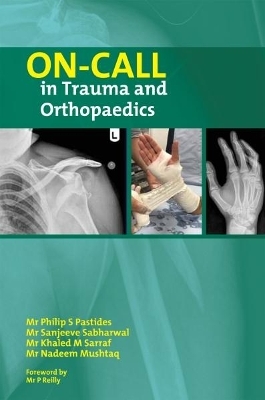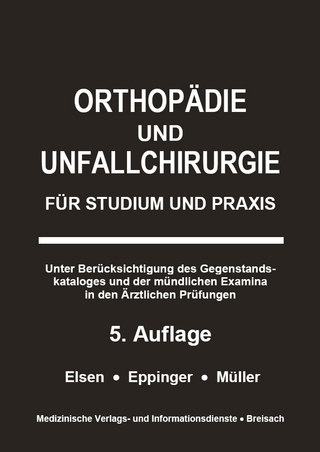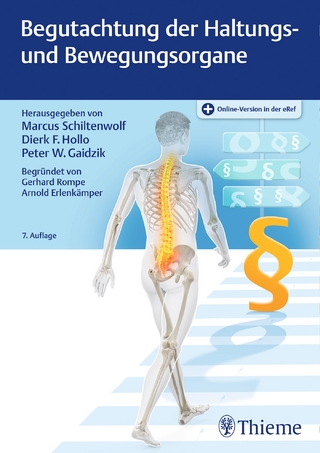
On Call in Trauma and Orthopaedics
Libri Publishing (Verlag)
978-1-911450-24-5 (ISBN)
at junior trainees working with the specialty of Trauma and Orthopaedics. It is
written in a clear and concise method, covering all common injuries that a
junior trainee would expect to see during their shifts.
On Call in Trauma and Orthopaedics is aimed
at junior trainees working with the specialty of Trauma and Orthopaedics. It is
written in a clear and concise method, covering all common injuries that a
junior trainee would expect to see during their shifts. With essential imaging,
schematic diagrams and ‘top tips’ sections, this book is written as a ‘survival
guide’ to allow the reader to manage patients in the emergency, ward and clinic
setting.
Why buy On call in Trauma and Orthopaedics?
This book not only provides a comprehensive
guide to common injuries, but also includes a basic examination and technical
skills section. The more advanced sections such as classification of common
fractures and consenting for common operations will career Trauma and
Orthopaedic trainees a higher insight into the specialty.
What’s inside:
Essentials: History, examination and classification
Emergency Department: Limb threatening conditions, Adult Upper/Lower limb injuries,
paediatrics and more
Operating theatre: How to prepare your patient for theatre
Ward: Pre
and post operative management of your patients
Clinic: What
to say, ask and do when admitting a patient from clinic
Procedures:
Step by step guide to simple procedures such as aspiration of joints and
reduction of fractures/joint dislocations
Philip S. PastidesPhilip is a post CCT Knee Fellow in Trauma and Orthopaedics at Guys and St Thomas in London. Deanery. He has numerous publications in peer reviewed journals, international and national podium and poster presentations. He is also a Member of the Academy of Medical Educators. He has a special interest in biomechanics and stem cells. Sanjeeve SabharwalSpecialist Registrar in Orthopaedic Surgery at Imperial College NHS Trust. Khaled M. SarrafMr Khaled Sarraf qualified from Guy's, King's and St Thomas' Medical School (King's College London) and completed his basic surgical training at Guy's and St Thomas' Hospital. He then undertook his higher surgical training in trauma and orthopaedic surgery on the Imperial north west Thames rotation. Subsequently Mr Sarraf received his fellowship surgical training at the Royal National Orthopaedic Hospital, Stanmore, London and St Michael's Hospital, University of Toronto in Canada as well as spending some time at the Hospital for Sick Children in Toronto (SickKids). Following his fellowships, Mr Sarraf was appointed as a consultant in trauma and orthopaedic surgery at Imperial College Healthcare NHS Trust with a special interest in children's orthopaedics, hip and knee conditions and sports injuries in all ages. Mr Sarraf was a lead in education during his higher training and continues to be active in surgical education as an honorary senior clinical lecturer at Imperial College London. Nadeem MushtaqMr Nadeem Mushtaq is a fellowship-trained orthopaedic consultant specialising in all disorders of the foot and ankle. He qualified from St George's Hospital, London in 1996 and completed his senior training on the rotation at Guy's and King's College hospitals, during which time he also undertook research at Brighton University obtaining a Master's degree in orthopaedics. He completed his training in 2012 and took an additional one year foot and ankle fellowship. He was appointed to Imperial College Healthcare NHS Trust hospitals in 2013 as a trauma and foot and ankle surgeon. He also has an honorary contact with Guy's Hospital. Mr Mushtaq has presented at orthopaedic meetings nationally and internationally.' He publishes research articles as well as writing and editing textbooks. He is passionate about teaching. Mr Mushtaq works almost exclusively with foot and ankle trauma and elective patients and undertook over 500 foot and ankle procedures last year alone.
About the editorial team viAbout the On-Call Series viiDedication viiiAbbreviations ixForeword xIntroduction 1Disclaimer 2Essentials 3Patients under your care 3Referrals 4Admissions 5Neurovascular assessment 7Classification of common fractures 12The trauma meeting 18Emergency Department 21Admitting and sending home patients from the ED 21Disabling, limb or life-threatening conditions. 23Upper limb 29Clavicle fractures 29Shoulder dislocation 30Proximal humerus fracture 33Humeral shaft fractures 35Distal humerus fractures 37Olecranon fractures 38Elbow dislocation 40Forearm fractures 42Distal radius fractures 44Lunate/perilunate dislocation 47Base of thumb fractures 49Boxer’s fracture (little finger metacarpal neck fracture) 50Lower limb 53iv On-call in Trauma and OrthopaedicsNeck of femur fractures 53Femoral shaft fractures 56Hip dislocation 58Distal femoral fractures 60Tibial plateau fractures 62Knee dislocation 64Tibial shaft fractures 66Tibial plafond fractures 68Ankle fractures 70Tarsometatarsal fracture-dislocation 72Metatarsal fractures 74Paediatric injuries 76BOAST guidelines 86Operating Theatre 89Preparing a patient for theatre 89Fasting instructions 90Patients on anticoagulants 91Patients requiring emergency operations 92Consent for common operations 93The Ward 99General Principles 99The multidisciplinary team 100Orthogeriatricians 100Physiotherapists/hand therapists 100Occupational therapists 100Multidisciplinary team (MDT) meetings 101General post-operative management 102Wound management 102Wound infections 102Plaster casts 103Post-operative radiographs 103Ward management of patients with common injuries 104Patients with a hip fracture 104On-call in Trauma and Orthopaedics vPatients with a wrist fracture 105Patients with an ankle fracture 105Patients with tibial shaft fractures 106Paediatric patients 106Clinic 107Fracture clinic 107Virtual fracture clinic (VFC) 109The plaster room 110Admitting patients from clinic 111Procedures 113Haematoma block using local anaesthetic 113Manipulation and reduction of dorsally displacedwrist fracture 115Manipulation and reduction of ankle fracture 117Manipulation and reduction of shoulder dislocations 119Application of skin traction 121Ring/digital block 123Knee aspiration 124Index 126
| Erscheinungsdatum | 01.11.2018 |
|---|---|
| Mitarbeit |
Herausgeber (Serie): Arpan Tahim |
| Zusatzinfo | Illustrations, color |
| Verlagsort | Faringdon |
| Sprache | englisch |
| Maße | 189 x 246 mm |
| Gewicht | 300 g |
| Themenwelt | Medizinische Fachgebiete ► Chirurgie ► Unfallchirurgie / Orthopädie |
| Medizin / Pharmazie ► Medizinische Fachgebiete ► Notfallmedizin | |
| ISBN-10 | 1-911450-24-7 / 1911450247 |
| ISBN-13 | 978-1-911450-24-5 / 9781911450245 |
| Zustand | Neuware |
| Informationen gemäß Produktsicherheitsverordnung (GPSR) | |
| Haben Sie eine Frage zum Produkt? |
aus dem Bereich


